This is really long and I just hope someone finds a tidbit or two that are helpful to them.
There are about a zillion ways to make jerky.
I have tried at least half a zillion of them over the years.

I have been making jerky from venison and beef for 25 years and have tried every trick and technique I could find. This includes the oven, a RONCO vertical convection dealie, and now a real dehydrator (Excalibur 2500) with my FEC 100.
The following is the process that I have settled on, but it is in no way the perfect way.
Just works for me.
MEAT SELECTION:
Any lean beef or other lean meat will work.
I even made Turkey Jerky (YUCK

) for my daughter one time.
From a taste perspective, the best tasting jerky I make is from a Brisket. I have "blind taste" tested it a couple of times at comps. Brisket won the taste test hands down followed by round and venison in a virtual tie.
BUT--lots of waste and a real challenge to do brisket "right". If the fat is not rendered out well, it will go rancid quickly.
And, a very expensive jerky due to low yield.
I used to make a lot of venison jerky on “halves”. But, I moved away from my hunting friends in Alabama so no longer have a source for venison.
That leaves me with Eye of the Round as my meat of choice.
Much more affordable, if not quite as tasty.
 MEAT PREPARATION:
MEAT PREPARATION:
Any of the round roasts work great, including Top and Bottom Round, but the Eye of the Round works the best with the smallest waste. Great value.
This is 4 of the 12 roasts in the case I just bought.
Two batches for me.

To cut it, I cut 3/4 to 1 inch slices across the grain. Kinda like a hockey puck. The width of the slices here determines the width of the finished slices. Then trim the exterior fat from each piece. Easy.
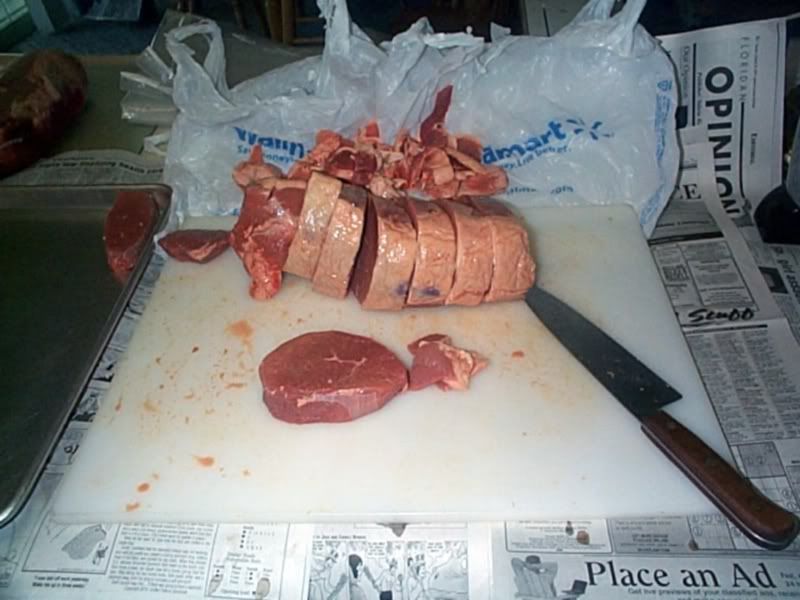
These hockey pucks are placed on a cookie sheet and “smashed” together to make them oblong. This gives longer slices with fewer short ones.
Then, into the freezer for several hours or overnight.

Then, I cut the hockey puck into 1/4 inch slices to make the final pieces.
Even my cheapo electric slicer cuts the frozen pieces well because they are only ¾ to 1 inch thick and I am cutting “through the grain”, so to speak.
This creates a fantastic texture because the grain runs "across" the piece. When you take a bite off the piece, it comes off clean and has a great mouth feel.
Those are my Myron Mixon "wannabe" gloves

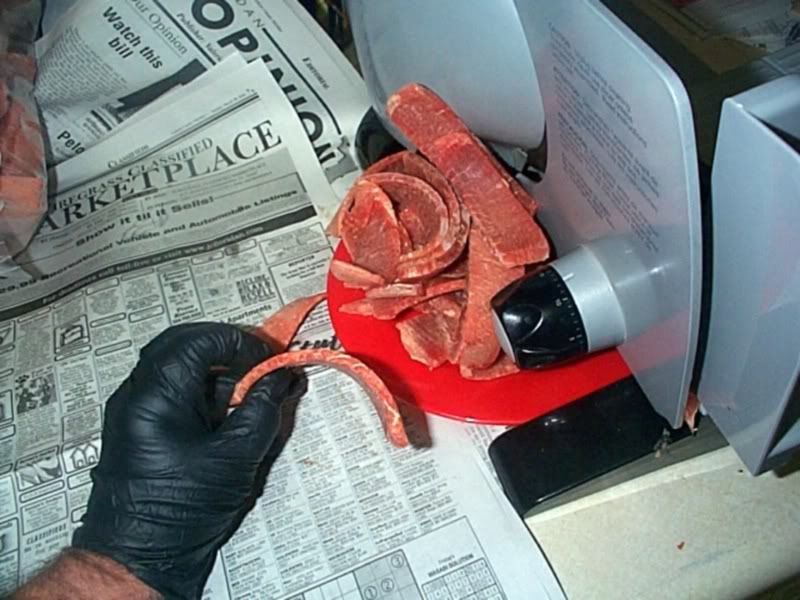
This is two roasts vacu-sucked and ready for the freezer.
I normally prep a full case and freeze this way.
Makes it really nice and easy to just pull out two bags, thaw, season, and cook. By-passes all the messy meat prep work and cleanup. I am basically lazy!

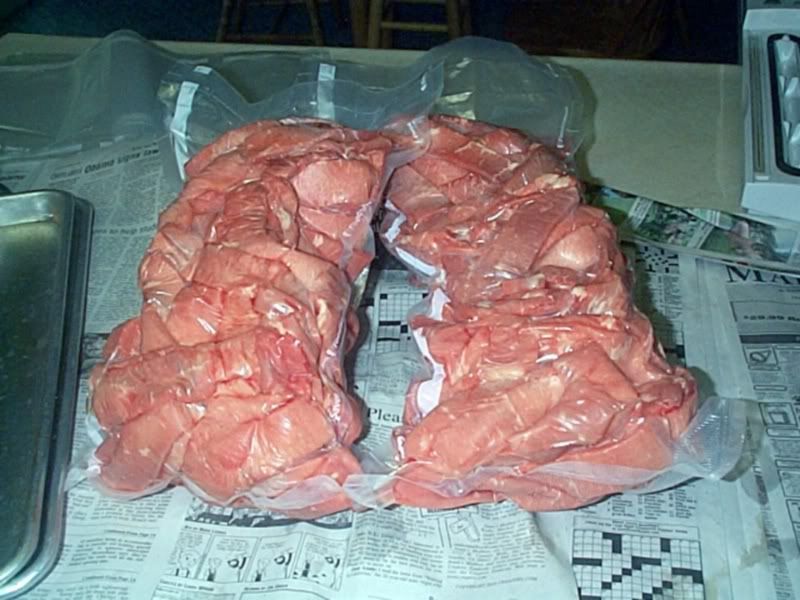 MARINADING and “SPICEING“:
MARINADING and “SPICEING“:
My marinade varies depending on my mood, supplies on hand, and person(s) the jerky is going to.
For example, I have friends and sons in Texas who will not let me into the state unless I bring some blistering hot jerky for them. I kick up the Tabasco in the marinade and the cayenne pepper in the Essence for more heat.
My ingredient list is long, but I may use just some or all as I desire.
The only thing that is constant is lots of soy sauce (½ cup) and 1/8th (or more) cup of Worschester per pound of raw meat.
I buy Soy Sauce by the half or full gallon at Sam's, so it is cheap.
I want it swimming in the sauce so it gets covered well.

And, it soaks up an amazing amount of marinade.
Soy Sauce
Liquid Smoke
Green/Chipotle Tabasco
Red Tabasco
Red Pepper Flakes
Morton Hot Salt
Kosher Salt
Worchestire
Maggi
BBQ Sauce
This is one roast in each 2.5 gal Ziplock.

I leave the meat wet when getting ready for the smoker. Helps to bond the Essence. Just a quick drain in the colander is plenty.
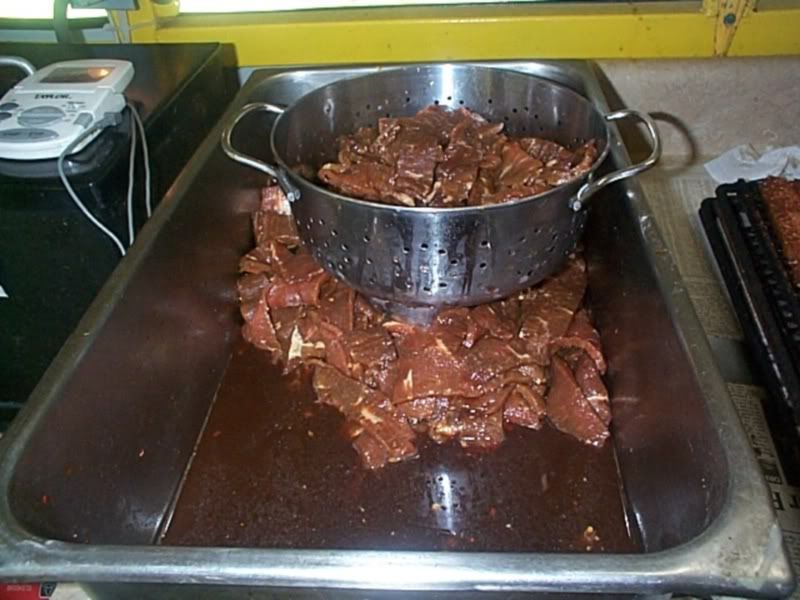
I dust the slices with Emeril’s Essence on one side prior to smoking.
The more Essence, the spicier the jerky.
2- 1/2 tablespoons paprika
2 tablespoons salt
2 tablespoons garlic powder
1 tablespoon black pepper
1 tablespoon onion powder
1 tablespoon cayenne pepper
1 tablespoon dried leaf oregano
1 tablespoon dried thyme
Combine all ingredients thoroughly and store in an airtight jar or container.
Yield: about 2/3 cup
I have used several commercial Beef Rubs and they worked well also.
I just like the Essence the best and it is cost effective.
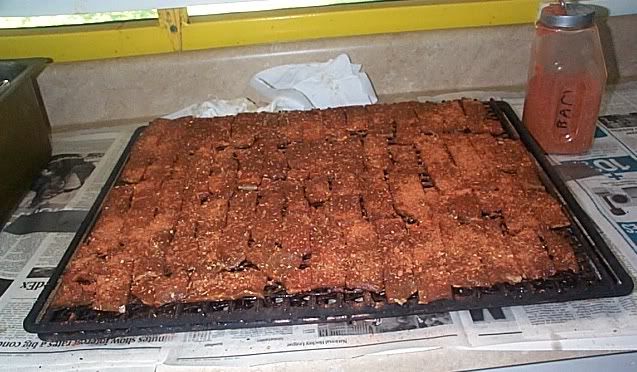
I prep two Eye of the Rounds per batch of jerky. That is 12-14 pounds of raw meat which makes a full load in my dehydrator later. Yield is 7-9 pounds, or about 75%. At $2.50/pound, that is about $4-$6/lb or so meat cost for the finished jerky. Not bad at all. For comparison, Brisket (pre-rimmed flats) yields 40 % or less. At $3.78/lb, that is about $10/lb (+) for meat cost.
For this run, I bought a case of CAB eye of the round, prepped it all and vacuum bagged it for future use. It is really nice to just pull out two bags of meat, thaw, marinade, and dehydrate without the mess of meat prep each time.
DEHYDRATING PROCESS:
First off--"Dehydrating" is just that--"removing moisture".
Some folks cook the jerky from start to finish in a smoker, but I have tried every trick I can find to smoke jerky from start to finish and have always failed. Mine winds up just being horribly overcooked (burned) meat with a real short shelf life.
I admire the folks who can just cook/smoke it and get great results.
I use a two step dehydrating process that blends the smoker’s taste with a “low heat and a lot of airflow” finish in the dehydrator.
I am blessed with a FEC, so I have total control of temps. Any smoker will work, as long as the temps can be controlled down below 180 or so.
I now smoke jerky for 3 hours at 166-170 degrees using pure mesquite pellets or 4 hours if using hickory pellets.
This cooks the meat to food safe levels, starts the drying process, and adds some YUMMY smoke flavor.
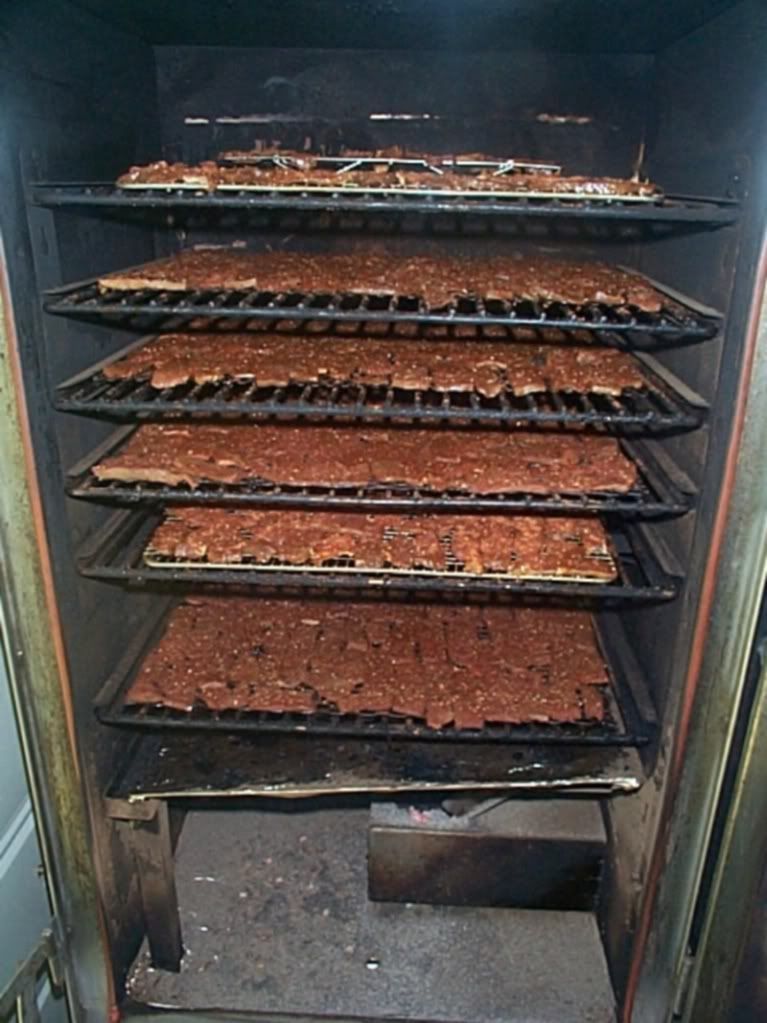
At the end of the smoke cycle, the bottom of the jerky (especially brisket) will have rendered fat beads that look like a morning dew. That is flavor and dries up in the next step. Good stuff.
Then, they go to the dehydrator for finishing.
I use an Excalibur 2500 with 5 trays at a max temp of about 145 and it takes about 6-8 more hours. I rotate the shelves every couple of hours and “sample” the jerky each time.
That may be why it is hard for me to exactly determine yields.

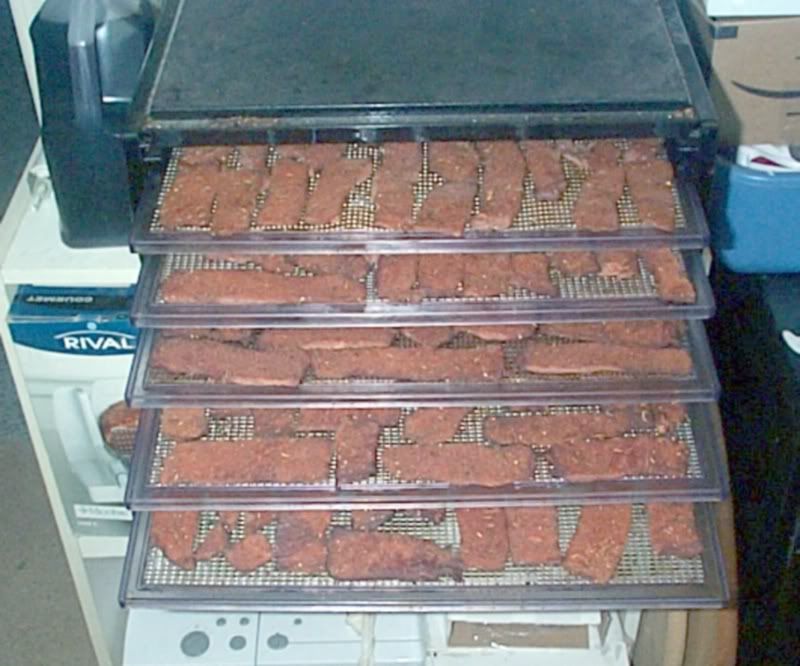
The jerky is done when it “breaks” right, showing white along the break.
This needs to be done when the jerky is cool/cold.
I actually "overdry" mine--kinda (actually very) brittle.
It is easy to add moisture by leaving the bag open on a humid day, but it will go rancid if not fully dry.
EQUALIZING:
No matter how careful I am, there are still slices that are thicker than others.
Obviously, the moisture (doneness) will vary with the thickness.
I put
all of the jerky in one Zip-Lock and set it on the counter for a day or two.
The dryer slices will pull moisture from the moister ones and it will all wind up with relatively equal moisture content.
Then I break it up into pint, quart, or gallon bags for storage or delivery.
The bag here is two roasts after a "whole bunch" of sampling!
This shows how well the slices break apart into bite size pieces.
Each horizontal row was a piece of jerky easily broken into the right size for eating.

This is the yield from the 4.41# Brisket flat--about 1.3# finished for a yield of about 25% this time.
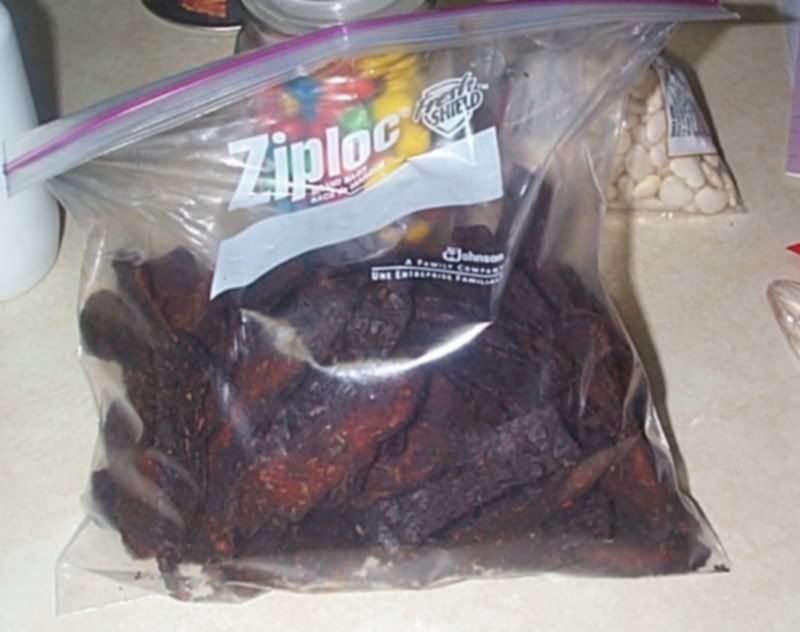 STORAGE:
STORAGE:
I keep the jerky in a refridge. It lasts just fine at room temperatures, but stays “fresher” in the refridge.
Like I said, lots of ways to do it. This just works for me.
Maybe someone can find some useful thoughts in this.
If you waded all the way through this---THANKS!!!!
TIM